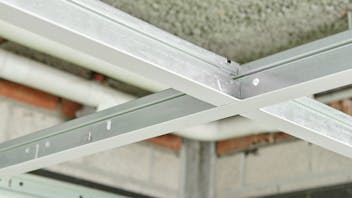Suspended ceiling tile installation starts with a sturdy framework and a ceiling grid layout. Our Chicago Metallic® suspension systems are manufactured of aluminum or steel, and are produced with recycled content. Performance requirements may require light-, intermediate- or heavy-duty ceiling suspension systems.
A suspension system also can be based on either an exposed or a concealed ceiling grid layout. Aesthetics, or a need to frequently access the plenum, will dictate that choice. An exposed grid is used for holding acoustical ceiling tiles or metal panels, which are either square or tegular / reveal. The suspension is visible and there are several types available to meet these requirements. A suspended grid can also be concealed by the edges of acoustical and specialty metal ceiling tiles with special concealing edges to cover the grid for a more monolithic look. Ceiling grid can also be used for suspending drywall in lieu of studs or as part of a gypsum board false ceiling installation.
Ceiling grid installation.
Ceiling grid installation is usually a quick, straightforward process when you have the right products, tools and follow industry-standard methods. Installation methods of ceiling suspension systems on commercial buildings are enforced by ASTM C636 “Standard Practice for Installation of Metal Ceiling Suspension Systems for Acoustical Tile and Lay-In Panels.” This standard calls for proper installation of ceiling components, such as:
- The spacing of main runners at 4 feet on center
- Minimum 12-gauge hanger wires
- Hanger wire wrapped with three tight turns over a 3-inch length
- Hanger wire within 3 inches of expansion reliefs unless otherwise tested
- Counter-sloping allowed under specific circumstances1
In addition to drop ceiling tile installation for standard applications, be aware of requirements for specialty applications and performance of suspended ceiling systems. In the U.S., this includes ASTM E580 “Standard Practice for Installation of Ceiling Suspension Systems for Acoustical Tile and Lay-in Panels in Areas Subject to Earthquake Ground Motions.”2
Along with the ASTM standards, the Ceilings & Interior Systems Construction Association (CISCA) also offers industry-accepted guides that are referenced in building codes and construction specifications throughout North America. The CISCA Ceiling Systems Handbook includes proper methods of installing ceiling tile grid, drop ceiling grid and suspended ceiling grid, among other types of suspension systems for exposed, concealed and specialty metal systems.
According to the CISCA handbook, after completing the room layout, installation of the grid suspension system for an exposed ceiling grid typically includes these steps:
- Install hangers
- Install first main runner
- Install cross runners between first main runner and wall molding
- Square the main runner with the wall and clamp or permanently attach it using pop rivets
- Use the first main runner as a basis to install hanger wires and main runners across the space
- Install the filed cross tees
- Check for square and install the remaining cut perimeter tees
- Cut and Install ceiling board, panels or tiles in the grid3
What’s the best way to cut suspended ceiling grid?
The most common tool for cutting ceiling suspension systems is a sharp pair of aviation snips. However, with some of the designer profiles such as bolt slot or double reveal systems, the best results are achieved with an appropriate metal-cutting blade on a miter saw. When using a miter saw, we recommend that you use all appropriate personal protective equipment, while also taking every safety precaution.
Take the grid component to be cut and place it, laying on its side, firmly against the saw’s backstop. Once the blade is at full speed, slowly cut the grid component. Pushing the saw too quickly will cause the blade to distort the grid, resulting in sharp edges and poor cut quality. Remember, maintaining a sharp blade is crucial to clean cuts.
If you choose to cut with aviation snips, follow these steps:
- Snip the bead toward the flange of the grid.
- Bend the grid open to allow for a cross cut of the grid face.
Sources
1. ASTM, https://www.astm.org/Standards/C636.htm
2. ASTM, https://www.astm.org/Standards/E580.htm
3. CISCA, https://www.cisca.org/i4a/pages/index.cfm?pageid=3281












